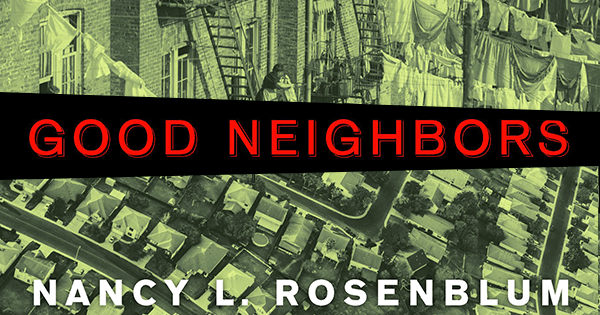Good Neighbors
An excerpt from Nancy L. Rosenblum’s new book about everyday American life

Good neighbors—the ones who check that your front door is locked, feed your dog, make sure you’ve got a flashlight when the power goes out—are indispensable, in life and in literature. Think of the close-knit communities in Willa Cather’s novels and the people who helped each other in the aftermath of Hurricane Katrina. Our history is also home to bad neighbors: those who looted and destroyed Japanese Americans’ homes during World War II, or the townspeople who committed (and attended) public lynchings.
In Good Neighbors: The Democracy of Everyday Life in America, Nancy L. Rosenblum looks at how the family next door fits into our national narrative. How essential are neighborhoods to our conception of democracy? What makes for good neighbors, and why do we care so much about them?
Who is my neighbor? The answer is more elusive and more interesting than first appears. The old English roots of the word (“neah” as in near and “gebur” as in dweller) and the medieval reference to farming strips of common land (“the man who tills the next piece of ground to mine”) are historical reference points. But for us personally and individually, who counts as our neighbor is not automatic with proximity. Location is not enough. We don’t assign the status neighbor to everyone residing in an officially designated neighborhood. We don’t define our neighbors by police precincts, census tracts, school districts, mail carrier routes, or the historic and aesthetic contours of the place where we live. Nor is neighbor associated in our minds with sociologists’ “spatial logic” and the social mechanisms that go by the name “neighborhood effects.” For neighbor is a matter of both location and personal knowledge, of recognition. The people we identify as our neighbors are people we encounter regularly, even if the only acknowledgement is a nod or its opposite—a regular, rude display of disregard.
We assign neighbors a spot on our personal map of the lay of the land around home. That doesn’t extend to everyone living nearby, and the person residing closest to us may fall outside the domain of “actual contacts, connections, alliances.” The designation is not inclusive, then. Neighbor applies to those close to home who emerge from the background to affect the quality of our lives. We elect the good neighbors with whom we have willing encounters, though bad neighbors, the worst, often elect us. Sentimental representations of neighbor emphasize the sense of belonging to this place. The stock image is a small town with neighbors of long-standing. Harper Lee’s Atticus Finch was
Maycomb County born and bred; he knew his people, they knew him … The present generation of people who had lived side by side for years and years, were utterly predictable to one another: they took for granted attitudes, character shadings, even gestures, as having been repeated in each generation and refined by time.
That was rural Alabama in the 1930s. The longevity and familiarity built into the notion of neighbor are rare today. Within the limits of mobility and financial means, we resist randomness in electing where to live; still, the particular people next door fall to us without our choosing. Sorely or gratefully, we are aware of the accident of proximity.
Excerpted from Good Neighbors: The Democracy of Everyday Life in America, by Nancy L. Rosenblum. Published by Princeton University Press. Reprinted by permission.

